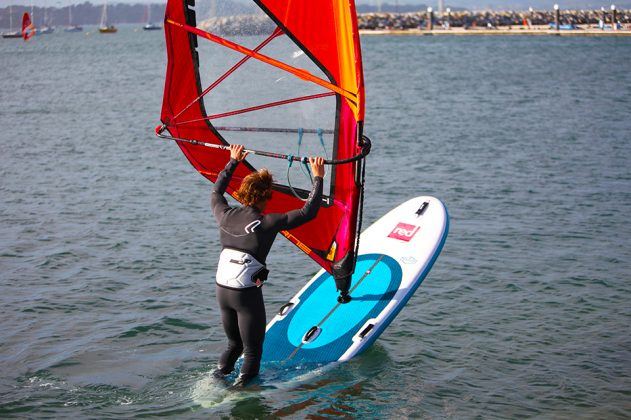WindSUP doesn’t just offer a light wind alternative, but also a gateway back into some potentially long-lost longboard skills, once the target of all windsurfers! So while you’re eyeing up those summer breezes, let’s look at a few top tips to make the most out of your WindSUP this summer.
Words Sam Ross // Photos Dan Hallam
Tune-up
WindSUPs can be some of the earliest planing boards on the water as their waterline length helps the transition between displacement and planing. But to get the most out of light winds, make sure that small rig you’ve popped on the board is going to perform as best as possible. Whilst reducing downhaul is good, make sure that the outhaul is loose enough too. In sub-planing
conditions the sail should be able to easily touch the boom a wrist’s length out from the clew without too much pressure.
Short or long
How you get upwind will vary depending on the length of your board. If your WindSUP is short with no centre fin or daggerboard, then upwind is all about the windward rail. Look upwind, get the feet out and forward and sink the windward rail in whilst pulling down through the boom, so you are helping the board to stop slipping sideways as you’re heading upwind. The harder you sink your weight down through the boom the more you can bury the windward rail and get yourself upwind. For longer boards, the style feels a little smoother and the technique is almost entirely opposite to shorter boards. If you have a daggerboard or long centreline, bring your feet together, point them across the board and push down on your toes. Driving off the daggerboard will start to give you the height that you’re looking for and unlock the voyaging potential of your WindSUP.
The F word
Back in the day, whether you wanted to be an instructor or a highly skilled windsurfer, the flare gybe was the benchmark move. But as the carve gybe became more en vogue, the flare gybe became a forgotten move. But if you want to turn a WindSUP without the area needed for an oil tanker you’ll need this move in your arsenal, and the good news is you can have fun while you’re doing it! This move is mostly about foot placement and rig movement. Get back on the board, in fact, waaaay back. Lean the rig to the outside of the turn and banana your body to get your hips to the inside. If you’re sailing longboard style you can even weight the outside foot to turn even tighter. Make sure you step forward before moving into the rig flip. You can control how much the tail sinks by bending or extending your legs and also pushing down through the mastfoot. If you bend your knees you can let the tail sink a little more or even pull the rig over your head to reduce power. If you extend your legs and pull down through the mastfoot you can immediately flatten the board off.
So now you’re tuned right, can smash upwind quickly and spin round in the spot, you’re well set to use your WindSUP to tour, practice wave sailing or just drill some light wind skills!
“Use your WindSUP to tour, practice wave sailing or just drill some light wind skills!”

